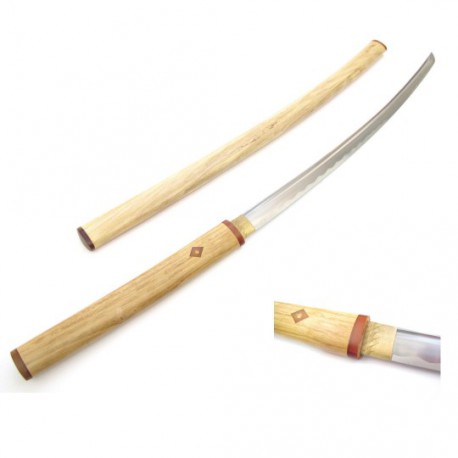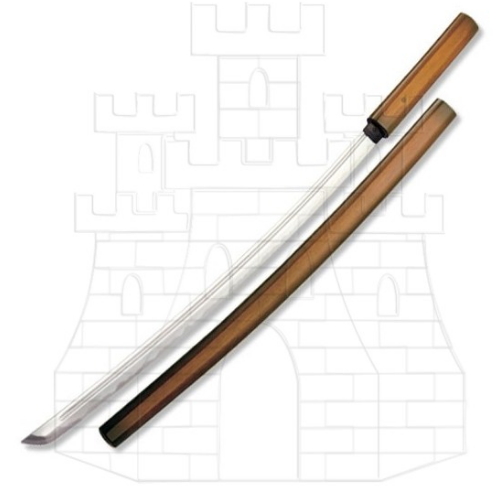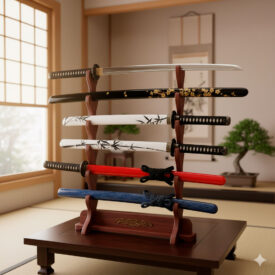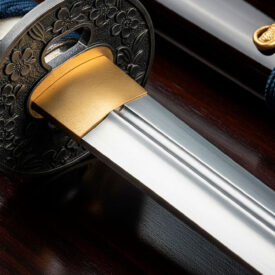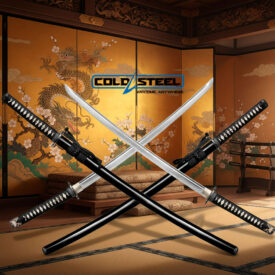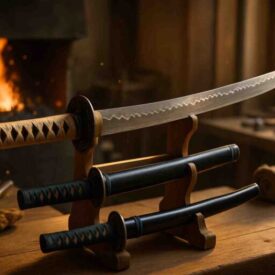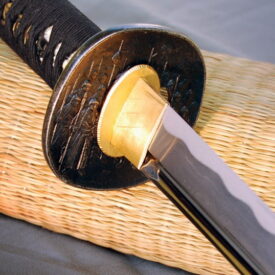When we think of a katana, we often picture an impressive weapon with its elaborate guard (tsuba) and braided handle (tsuka-ito). However, there is a much more discreet, yet equally crucial, covering for these iconic swords: the Shirasaya. If you’ve ever wondered what this simple wooden mount is, or why some Japanese blades are stored in it, this article will reveal its true purpose and fascinating history.
What Is a Shirasaya? The Scabbard That Holds a Secret
The term “Shirasaya” literally translates to “white scabbard.” But here, “white” refers not to its color, but to the absence of ornamentation or its “plain” nature. Essentially, it is a Japanese sword mount made only of a scabbard (saya) and a handle (tsuka), traditionally made of nurizaya wood. This type of wood was used to guarantee the perfect preservation of the blade when it was not going to be used for a long time.
Visually, a Shirasaya stands out for its simplicity: it lacks the distinctive guard (tsuba), and both the handle and the scabbard are usually of smooth wood, often without ray skin covering (same) or the traditional braiding (tsuka-ito). This unified look makes the sheathed blade appear as a single piece of wood. Despite its simple look, the handle still incorporates the necessary holes (mekugi-ana) to secure the blade’s tang (nakago). At times, experts would write directly on the Shirasaya’s scabbard important information about the blade, such as its origin, maker, or history, a process known as sayagaki.
The True Purpose of the Shirasaya: Preservation over Combat
The sole purpose of the Shirasaya is functional: it serves as a specialized storage system for the sword blade. Its minimalist, non-lacquered design is key to the long-term preservation of the blade.
Unlike the lacquered scabbards used in combat katanas—which can retain moisture and promote steel corrosion—the untreated wood of the Shirasaya allows the blade to “breathe.” This is vital to protect the delicate Japanese steel from damage or breakage, since factors such as sweat, dust, or blood can affect the blade if not properly maintained. Therefore, the Shirasaya helps preserve the integrity and sharpness of the blade when not in use. The Shirasaya was therefore not a sword designed to be used in combat, but rather to be better stored and preserved.
Shirasaya vs. Katana: Key Differences for the Warrior and Collector
It is crucial to understand that, while they may seem similar at first glance, the Shirasaya and the Katana have fundamentally different purposes and designs. One is a storage system; the other, a weapon of combat.
Design and Functionality
- The Shirasaya: Its simplicity, which is a strength for storage, becomes a serious limitation in battle. The lack of a tsuba (guard) leaves the user’s hand completely unprotected during an attack, and the lack of cotton, leather, or silk braiding (ito) on the handle makes it difficult to get a firm, secure grip. For these reasons, the Shirasaya is considered an ineffective mount as a combat weapon.
- The Katana: It is a Japanese sword characterized by its curved blade, a single edge, and a long two-handed handle. Historically, it was associated with samurai warriors of feudal Japan. Its design, including the tsuba and elaborate handle, is optimized for cutting and inflicting serious wounds in battle.
Ideal Use Scenarios
- Shirasaya: Ideal for long-term preservation of a blade with high historical or craftsman value. If you have a blade that is a collector’s item or family heirloom, the Shirasaya is the perfect option for storing it, allowing it to “breathe” and remain in optimal condition for generations.
- Katana: Designed for combat, martial arts training such as iaido or kenjutsu, or for test cutting (tameshigiri). This is the weapon a practitioner would use for training and development.
The Shikomizue: The Deceptive Brother of the Shirasaya
Although the Shirasaya was not a combat weapon, there was a type of sword that shared its plain look but served a covert fighting purpose. We’re talking about the Shikomizue, literally “prepared cane.”
This weapon adopted the features of the Shirasaya (no guard, one-piece wood appearance) to disguise the sword as a simple walking stick. It was a secret fighting tool, used by samurai or ronin who needed to hide their identity or weapon. The Shikomizue is a testament to Japanese cunning and martial strategy.
Guide to Choosing the Right Japanese Sword
Are You a Collector, Practitioner, or Enthusiast?
Your choice between a Shirasaya, a Katana, or even a Shikomizue will depend entirely on your purpose.
- For the collector and art lover: If your main interest is the art of forging, the history of Japanese swords, and proper preservation, a Shirasaya is an essential piece in your collection. It represents respect for the blade and its preservation.
- For the martial arts practitioner: If you are looking for a functional tool for training, iaido or kenjutsu, a Katana is the right option. Its design is optimized for combat, grip, and defense.
- For the history enthusiast: If you are fascinated by martial history and covert tactics, a Shikomizue can be a fascinating conversation piece and a very interesting historical replica.
What to Look For When Buying?
Whatever type of Japanese sword you choose, it is vital to pay attention to the quality of the blade, the wood of the scabbard, and the level of craftsmanship. A good Shirasaya will fit the blade perfectly, without looseness, and will be made from quality wood that ensures proper ventilation. In a Katana, the balance, the solidity of the handle, and the quality of the guard are crucial aspects.
Ultimately, the Shirasaya is much more than a simple case; it is a key piece in preserving the blade of a Japanese sword, a testament to dedication to craftsmanship and maintenance. Its humble appearance hides a vital function, ensuring these works of art and historical tools can endure through time.
If you want to explore the fascinating world of Japanese weapons, from traditional katanas to functional shirasayas, we invite you to visit our selection of Japanese swords, where you’ll find a wide variety of models for collectors and practitioners. Discover the perfect piece that suits your profile and your passion for samurai culture!

